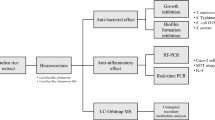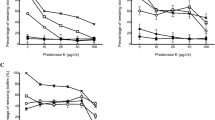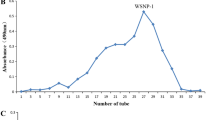Abstract
Many studies have demonstrated that natural plant extracts have inhibitory effects on microorganisms. The purpose of this study was to investigate the inhibitory effect of phenolic acids from rice straw (PAs) on Escherichia coli and their synergistic effect in combination with antibiotics. PAs can inhibit the growth of E. coli effectively by inducing the formation of H2O2; PA-treated cells had a tenfold greater intracellular H2O2 concentration than the control group. The synergistic effect caused by the interaction of PAs and antibiotics on inhibiting the growth of E. coli was significant. This effect may be caused by a PA-induced change in the permeability of E. coli cell membrane. The treatment with PAs made the extracellular K+ concentration reached 15 mg/L within 30 min, while the K+ concentration in the control group was very low and did not change significantly over time. Similarly to the extracellular K+, the extracellular protein concentration exceeded 150 mg/L in the PA treatment group, while it remained very low in the control group. Due to the increased cell permeability, more antibiotics can enter the cell. Hence, this study may provide a novel method of improving the safe use of antibiotics.






Similar content being viewed by others
References
Si, H., Hu, J., Liu, Z., & Zeng, Z.-L. (2008). Antibacterial effect of oregano essential oil alone and in combination with antibiotics against extended-spectrum beta-lactamase-producing Escherichia coli. FEMS Immunology and Medical Microbiology, 53(2), 190–194.
Servick, K. (2015). THE DRUG PUSH As fears of drug-resistant bacteria loom, governments try to coax companies back to the field. Science, 348(6237), 850–853.
Solomon, S. L., & Oliver, K. B. (2014). Antibiotic resistance threats in the United States: Stepping back from the brink. American Family Physician, 89, 938–941.
Anahi Portillo-Torres, L., Bernardino-Nicanor, A., Alberto Gomez-Aldapa, C., Gonzalez-Montiel, S., Rangel-Vargas, E., Roberto Villagomez-Ibarra, J., Gonzalez-Cruz, L., Cortes-Lopez, H., & Castro-Rosas, J. (2019). Hibiscus acid and chromatographic fractions from Hibiscus sabdariffa calyces: Antimicrobial activity against multidrug-resistant pathogenic bacteria. Antibiotics-Basel, 8(4), 218.
Bhattacharya, D., Bhattacharya, S., Patra, M. M., Chakravorty, S., Sarkar, S., Chakraborty, W., Koley, H., & Gachhui, R. (2016). Antibacterial activity of polyphenolic fraction of kombucha against enteric bacterial pathogens. Current Microbiology, 73(6), 885–896.
Luo, H., Liu, Z., Xie, F., Bilal, M., & Peng, F. (2021). Lignocellulosic biomass to biobutanol: Toxic effects and response mechanism of the combined stress of lignin-derived phenolic acids and phenolic aldehydes to Clostridium acetobutylicum. Industrial Crops and Products, 170, 113722.
Garrote, G., Dominguez, H., & Parajo, J. C. (2002). Autohydrolysis of corncob: Study of non-isothermal operation for xylooligosaccharide production. Journal of Food Engineering, 52(3), 211–218.
Saha, B. C. (2003). Hemicellulose bioconversion. Journal of Industrial Microbiology and Biotechnology, 30(5), 279–291.
Devendra, L. P., & Pandey, A. (2016). Hydrotropic pretreatment on rice straw for bioethanol production. Renewable Energy, 98, 2–8.
Hu, J., Xue, Y., Guo, H., Gao, M.-T., Li, J., Zhang, S., & Tsang, Y. F. (2017). Design and composition of synthetic fungal-bacterial microbial consortia that improve lignocellulolytic enzyme activity. Bioresource Technology, 227, 247–255.
Zheng, W., Zheng, Q., Xue, Y., Hu, J., & Gao, M.-T. (2017). Influence of rice straw polyphenols on cellulase production by Trichoderma reesei. Journal of Bioscience and Bioengineering, 123(6), 731–738.
Ma, X., Chen, X., Wang, X., Choi, S., Zhang, T.-A., Hu, J., Tsang, Y. F., & Gao, M.-T. (2019). Extraction of flavonoids from the saccharification of rice straw is an integrated process for straw utilization. Applied Biochemistry and Biotechnology, 189(1), 249–261.
Holopainen-Mantila, U., Marjamaa, K., Merali, Z., KaSper, A., de Bot, P., Jaaskelainen, A. S., Waldron, K., Kruus, K., & Tamminen, T. (2013). Impact of hydrothermal pre-treatment to chemical composition, enzymatic digestibility and spatial distribution of cell wall polymers. Bioresource Technology, 138, 156–162.
Oskoueian, E., Abdullah, N., Hendra, R., & Karimi, E. (2011). Bioactive compounds, antioxidant, xanthine oxidase inhibitory, tyrosinase inhibitory and anti-inflammatory activities of selected agro-industrial by-products. International Journal of Molecular Sciences, 12(12), 8610–8625.
Hernandez, M., Ventura, J., Castro, C., Boone, V., Rojas, R., Ascacio-Valdes, J., & Martinez-Avila, G. (2018). UPLC-ESI-QTOF-MS2-based identification and antioxidant activity assessment of phenolic compounds from red corn cob (Zea mays L.). Molecules, 23(6), 1425.
Xue, Y., Wang, X., Chen, X., Hu, J., Gao, M.-T., & Li, J. (2017). Effects of different cellulases on the release of phenolic acids from rice straw during saccharification. Bioresource Technology, 234, 208–216.
Coates, A. R. M., Hu, Y., Holt, J., & Yeh, P. (2020). Antibiotic combination therapy against resistant bacterial infections: Synergy, rejuvenation and resistance reduction. Anti-Infective Therapy, 18(1), 5–15.
Hossain, M. A., Park, H. C., Park, S. W., Park, S. C., & Kang, J. J. P. (2020). Synergism of the combination of traditional antibiotics and novel phenolic compounds against Escherichia coli. Pathogens, 9(10), 811.
Kim, H. R., & Eom, Y. B. (2021). Synergistic activity of equol and meropenem against carbapenem-resistant Escherichia coli. Antibiotics-Basel, 10(2), 13.
Wang, X., Tsang, Y. F., Li, Y., Ma, X., Cui, S., Zhang, T.-A., Hu, J., & Gao, M.-T. (2017). Inhibitory effects of phenolic compounds of rice straw formed by saccharification during ethanol fermentation by Pichia stipitis. Bioresource Technology, 244, 1059–1067.
Cui, S., Ma, X., Wang, X., Zhang, T.-A., Hu, J., Tsang, Y. F., & Gao, M.-T. (2019). Phenolic acids derived from rice straw generate peroxides which reduce the viability of Staphylococcus aureus cells in biofilm. Industrial Crops and Products, 140, 111561.
Gutierrez-Larrainzar, M., Rua, J., Caro, I., de Castro, C., de Arriaga, D., Rosario Garcia-Armesto, M., & del Valle, P. (2012). Evaluation of antimicrobial and antioxidant activities of natural phenolic compounds against foodborne pathogens and spoilage bacteria. Food Control, 26(2), 555–563.
Ma, Y., Ding, S., Fei, Y., Liu, G., Jang, H., & Fang, J. (2019). Antimicrobial activity of anthocyanins and catechins against foodborne pathogens Escherichia coli and Salmonella. Food Control, 106, 106712.
Wei, H., Wang, Y., Jin, Z., Yang, F., Hu, J., & Gao, M.-T. (2020). Utilization of straw-based phenolic acids as a biofugicide for a green agricultural production. Journal of Bioscience and Bioengineering, 131(1), 53–60.
Tao, R., Wang, C., Ye, J., Zhou, H., & Chen, H. (2016). Polyprenols of Ginkgo biloba enhance antibacterial activity of five classes of antibiotics. Biomed Res. Int, 4191938.
Barman, R., Mondal, T., Sarkar, J., Sikder, A., & Ghosh, S. (2020). Self-assembled polyurethane capsules with selective antimicrobial activity against gram-negative E. coli. ACS Biomaterials Science & Engineering, 6(1), 654–663.
Gu, H., Zhu, Y., Peng, Y., Liang, X., Liu, X., Shao, L., Xu, Y., Xu, Z., Liu, R., & Li, J. (2019). Physiological mechanism of improved tolerance of Saccharomyces cerevisiae to lignin-derived phenolic acids in lignocellulosic ethanol fermentation by short-term adaptation. Biotechnology for Biofuels, 12(1), 268–268.
Shi, J., Wang, Y., Wei, H., Hu, J., & Gao, M.-T. (2020). Structure analysis of condensed tannin from rice straw and its inhibitory effect on Staphylococcus aureus. Industrial Crops and Products, 145, 112130.
Skogman, M. E., Vuorela, P. M., & Fallarero, A. (2012). Combining biofilm matrix measurements with biomass and viability assays in susceptibility assessments of antimicrobials against Staphylococcus aureus biofilms. Journal of Antibiotics, 65(9), 453–459.
Abdel Hady, K. K., Abdel Salam, R. A., Hadad, G. M., & Abdel Hameed, E. A. (2020). Simultaneous HPLC determination of vildagliptin, ampicillin, sulbactam and metronidazole in pharmaceutical dosage forms and human urine. J. Iran Chem, 1–10.
Zhang, X., Liu, C., Li, Y., Song, J., & Zhao, X. (2016). Determination of kanamycin with the fading method of Congo red. Applied Chemical Industry, 45(7), 1376–1378. 1381.
Chen, X., Wang, X., Xue, Y., Zhang, T.-A., Hu, J., Tsang, Y. F., & Gao, M.-T. (2018). Tapping the bioactivity potential of residual stream from its pretreatments may be a green strategy for low-cost bioconversion of rice straw. Applied Biochemistry and Biotechnology, 186(3), 507–524.
Chen, X., Wang, X., Xue, Y., Zhang, T.-A., Li, Y., Hu, J., Tsang, Y. F., Zhang, H., & Gao, M.-T. (2018). Influence of rice straw-derived dissolved organic matter on lactic acid fermentation by Rhizopusoryzae. Journal of Bioscience and Bioengineering, 125(6), 703–709.
Belenky, P., Ye, J. D., Porter, C. B. M., Cohen, N. R., Lobritz, M. A., Ferrante, T., Jain, S., Korry, B. J., Schwarz, E. G., Walker, G. C., & Collins, J. J. (2015). Bactericidal antibiotics induce toxic metabolic perturbations that lead to cellular damage. Cell Reports, 13(5), 968–980.
Kohanski, M., Dwyer, D., Hayete, B., Lawrence, C. A., & Collins, J. J. (2007). A common mechanism of cellular death induced by bactericidal antibiotics. Cell, 130(5), 797–810.
Wright, G. D. (2007). On the road to bacterial cell death. Cell, 130(5), 781–783.
Xiang, F., Bai, J., Tan, X., Chen, T., Yang, W., & He, F. (2018). Antimicrobial activities and mechanism of the essential oil from Artemisia argyi Levl. et Van. var. argyi cv. Qiai. Industrial Crops and Products, 125, 582–587.
Funding
This work was supported by the National Key R&D Program of China (2017YFE0116300), the National Natural Science Foundation of China (32071640), and the Special Fund for Agroscientific Research in the Public Interest (No. 201503135–14).
Author information
Authors and Affiliations
Contributions
Huanran Wei, Zheng Jin: conceptualization, methodology, writing original draft, writing—review and editing, visualization. Min-Tian Gao: conceptualization, methodology, supervision, funding acquisition, writing—review and editing. Jiajun Hu: methodology. Yazhu Wang, Fan Yang, Ying Xiao, Yipeng Jiang: methodology, writing—review and editing.
Corresponding author
Ethics declarations
Ethics Approval
No related ethical issues.
Consent to Participate
The authors promise that the work described has not been published previously, that it is not under consideration for publication elsewhere, and that its publication is approved by all authors and tacitly or explicitly by the responsible authorities where the work was carried out.
Consent for Publication
The authors promise that if the manuscript is accepted, it will not be published elsewhere in the same form, in English or in any other language, without the written consent of the publisher.
Competing Interests
The authors declare no competing interests.
Additional information
Publisher's Note
Springer Nature remains neutral with regard to jurisdictional claims in published maps and institutional affiliations.
Huanran Wei and Zheng Jin have made equal contributions to this article and they are co-first authors
Rights and permissions
About this article
Cite this article
Wei, H., Jin, Z., Wang, Y. et al. Antibacterial Effect of Phenolic Acids Derived from Rice Straw and in Combination with Antibiotics Against Escherichia coli. Appl Biochem Biotechnol 194, 2931–2945 (2022). https://doi.org/10.1007/s12010-021-03650-5
Received:
Accepted:
Published:
Issue Date:
DOI: https://doi.org/10.1007/s12010-021-03650-5




